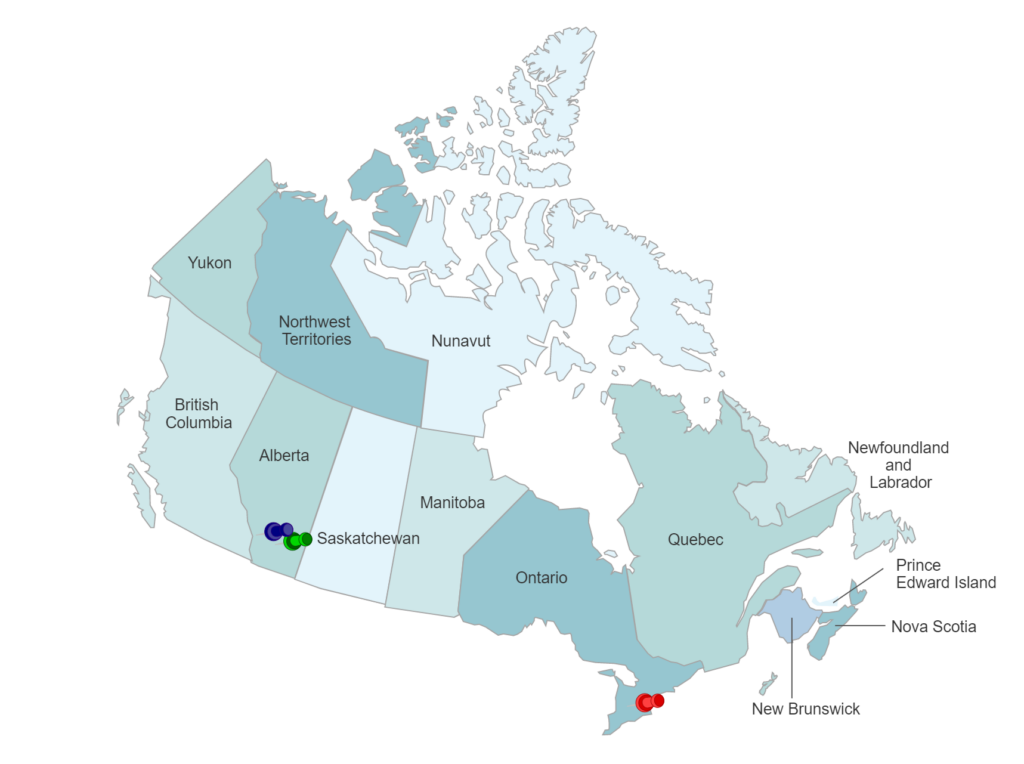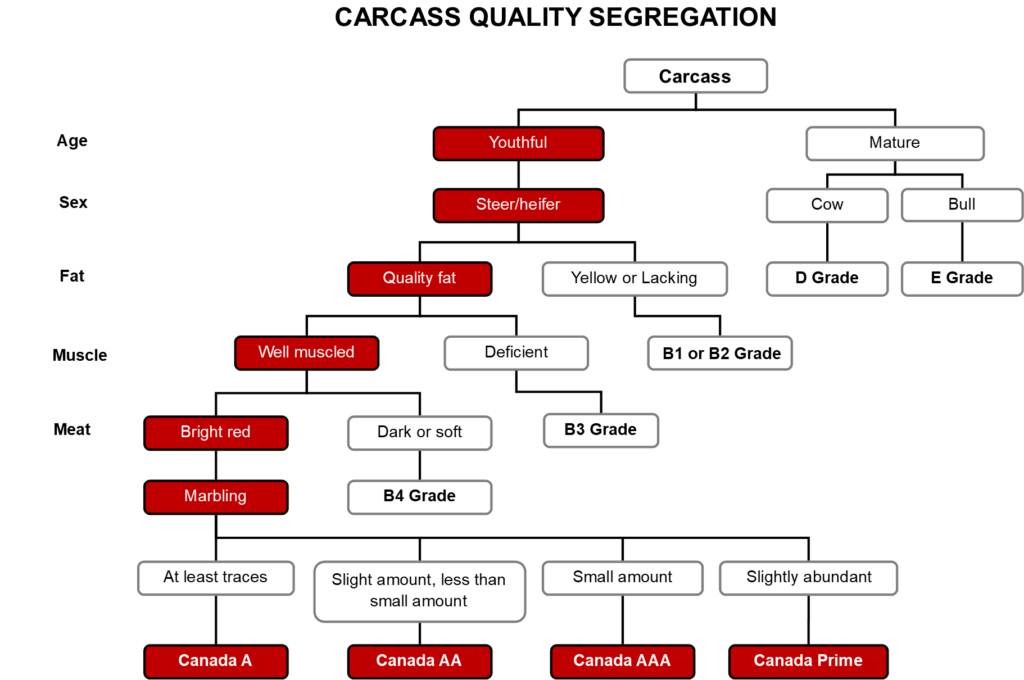On This Page:
System Overview
Meat Processing Plants
3 plants in Canada dominate beef processing:
- JBS Canada in Brooks, Alberta
- Cargill Foods in High River, Alberta
- Cargill Foods in Guelph, Ontario
Together, the two plants in Alberta account for 70% of all beef processed in Canada, and all three plants account for an estimated 85% – 95%, as well as nearly all of Canada’s $3 billion in beef exports [1, 2]. Both Cargill Foods and JBS are foreign-owned companies.
Hundreds of other processing plants exist in Canada, but they can’t compete with the huge scales and efficiencies of the three large plants.
Regulations introduced after the BSE or “Mad Cow” crisis in the mid 2000s outlawed the use of high-risk animal parts in animal feed, pet food and fertilizer, which made the profit margins even smaller. [1,3] Additionally, most animal proteins were banned from feed for ruminants (i.e. cattle and sheep) [3]. Without the large throughput required to turn a profit, many facilities went out of business [1].

Because of the limited number of effective processing plants, the three large plants effectively have a captive supply and can control both the price of cattle paid to farmers, as well as the price of beef paid by consumers [2].
Recommendations from the National Farmers Union of Canada to reduce the vulnerability of Canadian producers include:
- Price floors put in place to ensure producers are paid fairly by the processing plants for their cattle.
- Additional measures of Canadian agriculture success, in addition to export volumes.
- Developing domestic markets and localized distribution systems with direct, fair and transparent distribution chains [2].
Carcass Quality
Producing high-quality beef is the goal of producers and processors alike. The National Beef Quality Audit (NQBA) evaluates the beef industry and assesses the quality improvement over time.
Carcass quality can be impacted by [4]:
| How it affects carcass quality | Cost per head | How to prevent | |
| Liver abscesses | Livers with defects may be unfit for human consumption, as well as for pet food. | $20.98 | Good feed management practices, such as preventing grain overload. More research is underway to better understand prevention. |
| Bruising | Bruising can devalue primal cuts and cause increased trim. | $1.90 | Dehorn cattle when they are young. Use low-stress handling, non-slip flooring and smooth surfaces in handling and transport areas. |
| Horns | Horns can cause bruising to the carcass. | $0.06 | Dehorn cattle when they are young. Use polled (hornless) bulls when breeding. |
| Branding | Branding results in hide damage. | $1.07 | Use alternative forms of identification where possible. Locate the brand on the hip or shoulder, or use a smaller brand, to reduce the damage. |
| Injection site lesions | These lesions occur at the site of the injection and can result in tough beef and increased trim. | $0.56 | Replace needles as needed. Injecting in the neck rather than the hindquarters and use subcutaneous injections when possible. Avoid using dart guns. |
| Tag | The manure and mud on the animal’s hide. Tag damages the hide, decreases the yield, and requires increased labour to remove. | $10.21 | Keep pens and transport trucks clean and dry. Ensure pens have good drainage and bedding. |
The body condition score (BSC) assesses the amount of body fat on the animal on a scale from 1 (very thin) to 5 (grossly fat). The recommended BSC is around 3. Low BCSs indicate the cattle are underconditioned and may be injured during transport and have low productivity. High BCSs indicate the cattle are overconditioned and may have mobility issues, and if it is a cow they may have increased risk during calving.
Carcass grading is used to measure and communicate the quality of the beef product to the consumer. The Canadian Beef Grading Agency oversees the delivery of these gradings [5]. The grading is based on the age, sex, fat, muscle, meat and marbling of the meat, and is analyzed using computer vision systems to ensure consistency. Grades range from Canada Prime down to Grade E.

Price
As meat cuts vary in quality, there is a large range in price per cut. For example, ground beef is much less expensive than a filet mignon or ribeye.
Additionally, the meat packing plants largely control the price of beef. As Alberta has only two main meat packing plants, they are able to hold a duopoly and control the profit gained by the feedlot operators as well as control the price consumers must pay for the product.
Exports
Approximately 48% of Canadian beef is exported [6]. In 2020, Canada exported 937 million pounds (425 million kg) of beef, valued at $3.26 billion. [7]
A large majority of exports go to the United States, followed by Japan and China. [6,7]

Mad Cow Disease
Bovine spongiform encephalopathy (BSE), more commonly known as Mad Cow Disease, greatly impacted the processing of beef cattle in Canada.
BSE is a neurological disorder caused by infection with prions [8]. It can take between four to six years after infection for symptoms to start showing, such as changes in temperament and incoordination. The discovery of BSE in Alberta in 2003 resulted in an international trade ban that negatively impacted the livestock industry, resulting in large economic losses.
There are no treatments currently available for BSE. To prevent the spread, the brain, spinal cord, and several other components of the cow known as specified risk material (SRM) are removed and disposed of [9].
As of May 2021, Canada has been officially recognized by the World Organization for Animal Health as being a negligible risk for BSE [10].
System Elements
The visual below is based on a framework proposed by Davis et al. [13] to investigate complex systems. Click on each of the icons to learn more about each system element.
For a text-only version of the visual, you can use this page.
Stock photo.
Further Reading
References
[1] J. Edmiston, ‘Three meat-packing plants turn out 85% of Canada’s beef. How did this happen?’, Financial Post, May 06, 2020. Accessed: Aug. 23, 2022. [Online]. Available: https://financialpost.com/commodities/agriculture/why-only-three-meat-packing-plants-process-the-vast-majority-of-canadas-beef
[2] The National Farmers Union, ‘Meat packing concentration makes Canada’s food system vulnerable’, National Farmers Union, Apr. 22, 2020. https://www.nfu.ca/policy/meat-packing-concentration-makes-canadas-food-system-vulnerable/ (accessed Aug. 23, 2022).
[3] C. F. I. A. Government of Canada, ‘About Canada’s Enhanced Feed Ban’, Feb. 19, 2015. https://inspection.canada.ca/animal-health/terrestrial-animals/diseases/reportable/bovine-spongiform-encephalopathy/enhanced-feed-ban/eng/1424374475489/1424374476208 (accessed Aug. 23, 2022).
[4] National Beef Quality Audit, ‘2016/17 Plant Carcass Audit’, Nov. 2018. Accessed: Aug. 17, 2022. [Online]. Available: https://www.beefresearch.ca/content/uploads/2022/04/NBQA-Carcass-Audit-Mar-27-2018-F.pdf
[5] Canadian Beef Grading Agency, ‘Canadian Beef Grading Agency’. https://beefgradingagency.ca/ (accessed Aug. 23, 2022).
[6] Government of Canada, ‘Analysis of the beef supply chain’, Jul. 29, 2021. https://www150.statcan.gc.ca/n1/pub/18-001-x/18-001-x2021002-eng.htm (accessed Aug. 23, 2022).
[7] Canadian Beef, ‘Canada Beef Fast Fact Sheet’. Jun. 2021. Accessed: Aug. 23, 2022. [Online]. Available: https://canadabeef.ca/wp-content/uploads/2021/09/Canada-Beef-Fast-Fact-Sheet-2021.pdf
[8] Beef Cattle Research Council, ‘Bovine Respiratory Disease’, Beef Research, Jul. 25, 2022. https://www.beefresearch.ca/topics/bovine-respiratory-disease/ (accessed Aug. 17, 2022).
[9] Government of Canada, ‘Specified Risk Material – Requirements for Slaughtering Cattle and Processing Beef’, Nov. 20, 2018. https://inspection.canada.ca/animal-health/terrestrial-animals/diseases/reportable/bovine-spongiform-encephalopathy/srm/abattoirs-meat-processors/slaughtering-and-processing/eng/1369008282828/1369008283719 (accessed Aug. 23, 2022).
[10] Government of Canada, ‘World Organisation for Animal Health (WOAH) BSE Risk Categorization’, Dec. 16, 2021. https://inspection.canada.ca/animal-health/terrestrial-animals/diseases/reportable/bovine-spongiform-encephalopathy/risk-categorization/eng/1363872983008/1363873065426 (accessed Aug. 23, 2022).
[11] J. Herring, ‘Immigrant workers at Alberta meat plants vulnerable to dangerous conditions, research finds’, Calgary Herald, Nov. 25, 2021. Accessed: Aug. 23, 2022. [Online]. Available: https://calgaryherald.com/news/local-news/alberta-meat-plant-workers-vulnerable-to-dangerous-conditions-new-research
[12] South Dakota State University, ‘How Much Meat Can You Expect from a Fed Steer?’, Jul. 13, 2022. https://extension.sdstate.edu/how-much-meat-can-you-expect-fed-steer (accessed Aug. 23, 2022).
[13] M. C. Davis, R. Challenger, D. N. W. Jayewardene, and C. W. Clegg, ‘Advancing socio-technical systems thinking: A call for bravery’, Appl. Ergon., vol. 45, no. 2, Part A, pp. 171–180, Mar. 2014, doi: 10.1016/j.apergo.2013.02.009.

